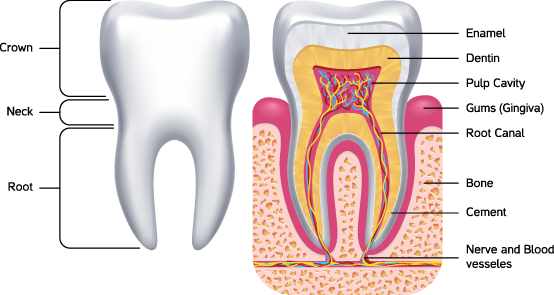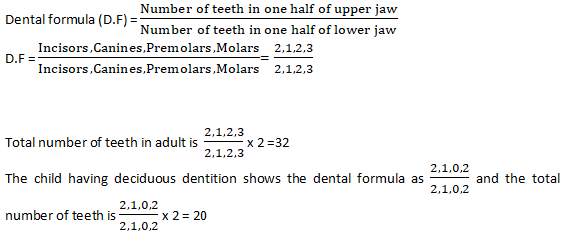
- Teeth are present on both the jaws; borne by the pre-maxillae and maxillae of the upper jaw and mandibles of the lower jaw.
- Human teeth are:
- Heterodont: Different shapes and types of teeth are present
- Thecodont: Firmly embedded in cup-like sockets of the jaw bones
- Diphyodont: Only two sets are present throughout life
- The first set is known as deciduous or milk dentition, which erupt through the gums usually six months or so after birth.
- Deciduous teeth are also known as temporary teeth which are 20 in number; 10 in each jaw.
- Permanent teeth begin to replace the deciduous teeth in the 6th year of age and complete set (32 teeth) of teeth appear by 24-25 years of age.
- Third molars commonly called wisdom teeth usually erupt between the ages of 17-21.
- The shedding of deciduous teeth and the appearance of permanent teeth follow a fairly constant pattern.
Types of teeth:
- Human teeth are heterodont and are of four different shapes or types. Among mammals, teeth are generally differentiated into four types;

https://ciroccodentalcenterpa.com/dental-hygiene/the-many-different-types-of-teeth/
-
- Incisors: The biting section is wide and thin, has chisel shaped cutting edge
- Canines: Pointed tooth, may have a single cusp in its crown
- Premolars: The tooth has two cusps (bicuspid teeth)
- Molars: They are flat teeth with four or five cusps
- The number and position of each type of teeth is definite and fixed in every mammal.
- In human beings, each jaw holds four incisors, two canines, four premolars and six molars and is represented by a dental formula.
Dental formula:
- It is expressed as the number of different types of teeth in both the jaws.
- The number of teeth in one half of the upper jaw is written above the line while the number of teeth in one half of the lower jaw is written below the line.
Structure of a tooth:
- Teeth are developed from both the dermis and epidermis.
- All teeth are basically similar in structure and have the same three parts as follows:
- Root:
- It is the lowermost part of a tooth.
- It remains embedded in a socket (alveolus) in the alveolar process of a jaw bone.
- Crown:
- It is the uppermost, visible part of a tooth.
- It projects upward from the gum.
- Neck:
- It is the middle narrow part of a tooth present between the root and crown.
- It is also called cervix and remains surrounded by the gum.
- The number of roots may vary with teeth. Incisors and canines have a single root. Premolars generally have one and sometimes two roots whereas molars have 2-4 roots.
- Root:

Composition of teeth and gums:
- Each tooth is composed of four major components; enamel, dentine, cement and pulp.
- Enamel:
- Enamel is the insensitive white and shiny covering of the crown.
- It is the hardest structure of our body and hence provides that strength to our teeth.
- In order to cut through enamel, a dentist uses a drill that spins at about half a million revolutions per minute.
- Dentine:
- Dentine is an extremely sensitive yellowish portion surrounding the pulp cavity.
- It is chemically bone-like and contains many fine canaliculi.
- It forms the bulk of the tooth.
- Cement:
- It is the bone-like covering of the neck and root.
- Pulp:
- There’s a cavity called pulp cavity inside the dentine.
- Pulp cavity consists of a soft core of connective tissue called pulp that is supplied with nerves and blood vessels.
- Blood vessels and nerves pass to the tooth through a small foramen (opening) present at the apex of each tooth root.
- Pulp consists of odontoblast cells that line the innermost surface of dentine.
- Processes of odontoblast cells extend through the dentine to the border with the enamel.
- The teeth’s sensitivity to pain is attributed to the odontoblasts, which convey the effects of stimulation to nerve endings in the pulp.
- Enamel:
Gum:
- Teeth are strongly attached on the jaw bones by the gum.
- Gum, also called gingiva, is a firm connective tissue covered with mucous membrane.
- It surrounds the alveolar processes of the teeth and is attached to the enamel of the tooth along the crown.
- The stratified squamous epithelium of the gums is slightly keratinized to withstand friction during chewing.
Functions of teeth:
- Teeth have three main functions:
- Mastication of food: Chewing of food with the help of teeth physically breaks them down into fine pieces.
- Incisors: Help in cutting down food with their sharp edges
- Canines: Help in tearing apart food
- Premolars: Help in tearing and crushing of food
- Molars: Help in crushing and grinding food
- Clear pronunciation: Teeth enable us to pronounce words properly and clearly.
- Shaping the face: Teeth gives proper shape to our face
- Mastication of food: Chewing of food with the help of teeth physically breaks them down into fine pieces.
